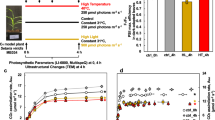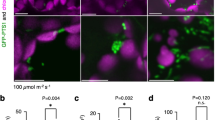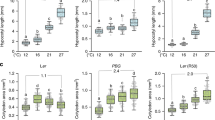Abstract
Faster onset of photoprotection could potentially increase biomass accumulation. Indeed, this has been realized in tobacco VPZ lines by overexpression of three photoprotective proteins in parallel. To explore the range of application of this approach, we generated Arabidopsis VPZ lines. These lines triggered photoprotection more rapidly, but growth rate and biomass accumulation were impaired under fluctuating light. This implies that the strategy might interfere with other mechanisms controlling excitation energy distribution, or with source–sink relationships or plastid signalling.
This is a preview of subscription content, access via your institution
Access options
Access Nature and 54 other Nature Portfolio journals
Get Nature+, our best-value online-access subscription
$29.99 / 30 days
cancel any time
Subscribe to this journal
Receive 12 digital issues and online access to articles
$119.00 per year
only $9.92 per issue
Buy this article
- Purchase on Springer Link
- Instant access to full article PDF
Prices may be subject to local taxes which are calculated during checkout



Similar content being viewed by others
References
Li, Z., Wakao, S., Fischer, B. B. & Niyogi, K. K. Sensing and responding to excess light. Annu. Rev. Plant Biol. 60, 239–260 (2009).
Pinnola, A. & Bassi, R. Molecular mechanisms involved in plant photoprotection. Biochem. Soc. Trans. 46, 467–482 (2018).
Ruban, A. V. Nonphotochemical chlorophyll fluorescence quenching: mechanism and effectiveness in protecting plants from photodamage. Plant Physiol. 170, 1903–1916 (2016).
Jahns, P. & Holzwarth, A. R. The role of the xanthophyll cycle and of lutein in photoprotection of photosystem II. Biochim. Biophys. Acta 1817, 182–193 (2012).
Hieber, A. D., Bugos, R. C. & Yamamoto, H. Y. Plant lipocalins: violaxanthin de-epoxidase and zeaxanthin epoxidase. Biochim. Biophys. Acta 1482, 84–91 (2000).
Zhu, X. G., Ort, D. R., Whitmarsh, J. & Long, S. P. The slow reversibility of photosystem II thermal energy dissipation on transfer from high to low light may cause large losses in carbon gain by crop canopies: a theoretical analysis. J. Exp. Bot. 55, 1167–1175 (2004).
Murchie, E. H. & Niyogi, K. K. Manipulation of photoprotection to improve plant photosynthesis. Plant Physiol. 155, 86–92 (2011).
Kromdijk, J. et al. Improving photosynthesis and crop productivity by accelerating recovery from photoprotection. Science 354, 857–861 (2016).
Goss, R. & Lepetit, B. Biodiversity of NPQ. J. Plant Physiol. 172, 13–32 (2015).
Glowacka, K. et al. Photosystem II subunit S overexpression increases the efficiency of water use in a field-grown crop. Nat. Commun. 9, 868 (2018).
Hubbart, S., Ajigboye, O. O., Horton, P. & Murchie, E. H. The photoprotective protein PsbS exerts control over CO2 assimilation rate in fluctuating light in rice. Plant J. 71, 402–412 (2012).
Suorsa, M. et al. PROTON GRADIENT REGULATION5 is essential for proper acclimation of Arabidopsis photosystem I to naturally and artificially fluctuating light conditions. Plant Cell 24, 2934–2948 (2012).
Tikkanen, M., Grieco, M., Kangasjarvi, S. & Aro, E. M. Thylakoid protein phosphorylation in higher plant chloroplasts optimizes electron transfer under fluctuating light. Plant Physiol. 152, 723–735 (2010).
Sinclair, T. R., Rufty, T. W. & Lewis, R. S. Increasing photosynthesis: unlikely solution for world food problem. Trends Plant Sci. 24, 1032–1039 (2019).
Chang, T. G., Zhu, X. G. & Raines, C. Source-sink interaction: a century old concept under the light of modern molecular systems biology. J. Exp. Bot. 68, 4417–4431 (2017).
Flügge, U. I., Westhoff, P. & Leister, D. Recent advances in understanding photosynthesis. F1000Res. 5, 2890 (2016).
Clough, S. J. & Bent, A. F. Floral dip: a simplified method for Agrobacterium-mediated transformation of Arabidopsis thaliana. Plant J. 16, 735–743 (1998).
Acknowledgements
The authors thank the Deutsche Forschungsgemeinschaft for funding (no. TRR 175, Z1) and K. Niyogi for sharing the VPZ construct.
Author information
Authors and Affiliations
Contributions
D.L. conceived the project. A.G.-M. and D.L. designed the experiments. A.G.-M. performed the experiments and analysed data. A.G.-M. and D.L. wrote the manuscript.
Corresponding author
Ethics declarations
Competing interests
The authors declare no competing interests.
Additional information
Peer review information Nature Plants thanks Christine Foyer and other, anonymous, reviewers for their contribution to the peer review of this work.
Publisher’s note Springer Nature remains neutral with regard to jurisdictional claims in published maps and institutional affiliations.
Extended data
Extended Data Fig. 1 Arabidopsis VPZ lines display enhanced dynamics of photoprotection under the fluctuating light regime FL1.
The experiment was carried out as described in Fig. 2a, except that the fluctuating light regime FL1 (6 cycles of 3 min at 50 μmol photons m-2 s-1 and 3 min at 500 μmol photons m-2 s-1) was applied. Dots represent the mean of n = 8 independent experiments and statistical differences for the three lines (nos. 2, 4 and 7) to WT according to a two-tailed Student’s t-test (P ≤ 0.05) are indicated with asterisks (*).
Extended Data Fig. 2 Electron transport rate (ETR) and NPQ in response to steady-state or fluctuating light regimes.
a, Design for steady-state (left) or fluctuating light (FL3) (right) response curves. b, c, Electron transport rate (ETR), defined as µmol photons, (b) and NPQ (c) in 4-week-old wild-type (WT) and 3 independent VPZ lines (nos. 2, 4 and 7). Dots represent the mean of n = 7 independent experiments. Corresponding data for standard deviations and statistical differences from WT according to a two-tailed Student’s t-test can be found as Source Data.
Extended Data Fig. 3 Photosynthetic response to extended exposure to high light.
Four-week-old wild-type (Col-0) and 3 independent VPZ lines (nos. 2, 4 and 7) grown under 12 h light/12 dark cycles (see Methods) were dark-adapted (20 min) to determine minimal and maximal fluorescence (Fo, Fm), then exposed to high light (500 μmol photons m-2 s-1) for 2 h and partially dark-adapted (10 min) to monitor Fo’ and Fm’. Photoprotection index, residual NPQ and maximum quantum yield of PSII (Fv/Fm) after partial dark adaptation are presented. Data are presented as the mean ± s.d. for n = 16 independent plants (indicated in circles) from 4 independent experiments and statistical differences from WT according to a two-tailed Student’s t-test (P ≤ 0.05) are indicated.
Extended Data Fig. 4 Growth and biomass accumulation in Arabidopsis VPZ lines under different light conditions.
a, Image of representative 3-week-old plants grown under CL conditions as in Fig. 3 and then exposed to high light (500 µmol photons m-2 s-1) for 1 week (HL); or cultivated for 4 weeks under continuous light (125 µmol photons m-2 s-1; CONT) or short day conditions (8 h at 125 µmol photons m-2 s-1, 16 h dark; SD). Bar: 1 cm. b,c, Statistical analysis of sets of plants with respect to rosette diameter (b) and fresh weight (c) grown as in panel a. Data are presented as the mean ± s.d. for n = 3 (HL) or 4 (CONT and SD) independent experiments indicated in circles and statistical differences to WT according to a two-tailed Student’s t-test (P ≤ 0.05) are provided.
Extended Data Fig. 5 Photosynthetic efficiency of Arabidopsis VPZ lines under different abiotic stresses.
WT (Col-0) and the three VPZ lines were cultivated for two weeks on soil under standard conditions (16 h at 22 °C and 125 µmol photons m-2 s-1; 8 h dark at 18 °C) (before treatment) and transferred to conditions with increased light intensity (500 µmol photons m-2 s-1, HL); continuous 32 °C (heat), or 4 °C and reduced light intensity (35 µmol photons m-2 s-1) (cold) or left under the standard conditions (control) for 4 days. The maximum quantum yield of photosystem II (Fv/Fm) was determined. Data are presented as the mean ± s.d. for n = 3 independent experiments indicated in circles and statistical differences to WT according to a two-tailed Student’s t-test (P ≤ 0.05) are shown.
Supplementary information
Supplementary Tables
Supplementary Tables 1 and 2.
Source data
Source Data Fig. 1a
Statistical source.
Source Data Fig. 1b
Unprocessed immunolots.
Source Data Fig. 2
Statistical source.
Source Data Fig. 3
Statistical source.
Source Data Extended Data Fig. 1
Statistical source.
Source Data Extended Data Fig. 2
Statistical source.
Source Data Extended Data Fig. 3
Statistical source.
Source Data Extended Data Fig. 4
Statistical source.
Source Data Extended Data Fig. 5
Statistical source.
Source Data Supplementary Table 1
Statistical source.
Rights and permissions
About this article
Cite this article
Garcia-Molina, A., Leister, D. Accelerated relaxation of photoprotection impairs biomass accumulation in Arabidopsis. Nat. Plants 6, 9–12 (2020). https://doi.org/10.1038/s41477-019-0572-z
Received:
Accepted:
Published:
Issue Date:
DOI: https://doi.org/10.1038/s41477-019-0572-z
This article is cited by
-
An open-source controller to build a dynamic light intensity setup
Plant Methods (2024)
-
Genetic and molecular basis of carotenoid metabolism in cereals
Theoretical and Applied Genetics (2023)
-
Genetic dissection of the roles of β-hydroxylases in carotenoid metabolism, photosynthesis, and plant growth in tetraploid wheat (Triticum turgidum L.)
Theoretical and Applied Genetics (2023)
-
N6-methyladenosine RNA modification regulates photosynthesis during photodamage in plants
Nature Communications (2022)
-
The role of photosynthesis related pigments in light harvesting, photoprotection and enhancement of photosynthetic yield in planta
Photosynthesis Research (2022)



